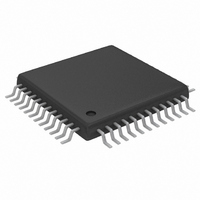MAX1195ECM+TD Maxim Integrated Products, MAX1195ECM+TD Datasheet - Page 20

MAX1195ECM+TD
Manufacturer Part Number
MAX1195ECM+TD
Description
IC ADC 8BIT 40MSPS DL 48-TQFP
Manufacturer
Maxim Integrated Products
Datasheet
1.MAX1195ECMD.pdf
(22 pages)
Specifications of MAX1195ECM+TD
Number Of Bits
8
Sampling Rate (per Second)
40M
Data Interface
Parallel
Number Of Converters
2
Power Dissipation (max)
108mW
Voltage Supply Source
Single Supply
Operating Temperature
-40°C ~ 85°C
Mounting Type
Surface Mount
Package / Case
48-TQFP Exposed Pad, 48-eTQFP, 48-HTQFP, 48-VQFP
Lead Free Status / RoHS Status
Lead free / RoHS Compliant
Dual, 8-Bit, 40Msps, 3V, Low-Power ADC with
Internal Reference and Parallel Outputs
Figure 11 depicts the aperture jitter (t
sample-to-sample variation in the aperture delay.
Aperture delay (t
rising edge of the sampling clock and the instant when
an actual sample is taken (Figure 11).
For a waveform perfectly reconstructed from digital
samples, the theoretical maximum SNR is the ratio of
the full-scale analog input (RMS value) to the RMS
quantization error (residual error). The ideal, theoretical
minimum analog-to-digital noise is caused by quantiza-
tion error only and results directly from the ADC’s reso-
lution (N-bits):
In reality, there are other noise sources besides quanti-
zation noise: thermal noise, reference noise, clock jitter,
etc. SNR is computed by taking the ratio of the RMS
signal to the RMS noise, which includes all spectral
components minus the fundamental, the first five har-
monics, and the DC offset.
SINAD is computed by taking the ratio of the RMS sig-
nal to all spectral components minus the fundamental
and the DC offset.
Effective number of bits (ENOB) specifies the dynamic
performance of an ADC at a specific input frequency
and sampling rate. An ideal ADC’s error consists of
20
______________________________________________________________________________________
Dynamic Parameter Definitions
SNR
dB[max]
Signal-to-Noise Plus Distortion
AD
) is the time defined between the
= 6.02
Effective Number of Bits
Signal-to-Noise Ratio
dB
✕
N + 1.76
Aperture Delay
Aperture Jitter
AJ
), which is the
dB
quantization noise only. ENOB for a full-scale sinusoidal
input waveform is computed from:
THD is typically the ratio of the RMS sum of the first four
harmonics of the input signal to the fundamental itself.
This is expressed as:
where V
V
harmonics.
Spurious-free dynamic range (SFDR) is the ratio
expressed in decibels of the RMS amplitude of the fun-
damental (maximum signal component) to the RMS
value of the next largest spurious component, exclud-
ing DC offset.
The two-tone intermodulation distortion (IMD) is the
ratio expressed in decibels of either input tone to the
worst third-order (or higher) intermodulation products.
The individual input tone levels are at -7dB full scale
and their envelope is at -1dB full scale.
TRANSISTOR COUNT: 11,601
PROCESS: CMOS
5
are the amplitudes of the 2nd- through 5th-order
THD
1
is the fundamental amplitude, and V
=
ENOB
20
Spurious-Free Dynamic Range
×
log
Intermodulation Distortion
Total Harmonic Distortion
=
SINAD
V
2
Chip Information
2
6 02
+
.
V
−1 76
3
2
V
.
+
1
V
4
2
+
V
5
2
2
through











